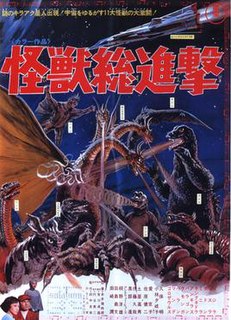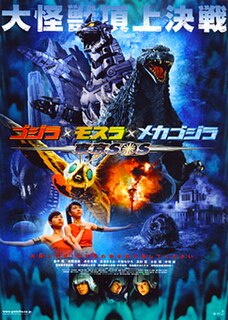 W
WMothra is a fictional monster, or kaiju, that first appeared in the 1961 film Mothra, produced and distributed by Toho Studios. Mothra has appeared in several Toho tokusatsu films, most often as a recurring character in the Godzilla franchise. She is typically portrayed as a colossal sentient larva (caterpillar) or imago, accompanied by two miniature fairies speaking on her behalf. Unlike other Toho monsters, Mothra is a largely heroic character, having been variously portrayed as a protector of her own island culture, the Earth and Japan. Mothra's design is influenced by silk worms, their imagos, and those of giant silk moths in the family Saturniidae. The character is often depicted hatching offspring when approaching death, a nod to the Saṃsāra doctrine of numerous Indian religions.
 W
WDestroy All Monsters is a 1968 Japanese kaiju film directed by Ishirō Honda, with special effects by Eiji Tsuburaya. The film, which was produced and distributed by Toho Co., Ltd, is the ninth film in the Godzilla franchise, and features eleven monster characters, including Godzilla, Mothra, Rodan, King Ghidorah, Anguirus, and Minilla. The film stars Akira Kubo, Jun Tazaki, Yukiko Kobayashi and Yoshio Tsuchiya.
 W
WEbirah, Horror of the Deep is a 1966 Japanese kaiju film directed by Jun Fukuda and produced and distributed by Toho Co., Ltd. The film stars Akira Takarada, Kumi Mizuno, Akihiko Hirata and Eisei Amamoto, and features the fictional monster characters Godzilla, Mothra, and Ebirah. It is the seventh film in the Godzilla franchise, and features special effects by Sadamasa Arikawa, under the supervision of Eiji Tsuburaya. In the film, Godzilla and Ebirah are portrayed by Haruo Nakajima and Hiroshi Sekita, respectively.
 W
WGhidorah, the Three-Headed Monster is a 1964 Japanese kaiju film directed by Ishirō Honda, with special effects by Eiji Tsuburaya. Produced and distributed by Toho Co., Ltd, it is the fifth film in the Godzilla franchise, and was the second Godzilla film produced that year, after Mothra vs. Godzilla. The film stars Yosuke Natsuki, Hiroshi Koizumi, Akiko Wakabayashi, with Haruo Nakajima as Godzilla, Masanori Shinohara as Rodan, and Shoichi Hirose as King Ghidorah. In the film, an extraterrestrial from Venus, possessing the body of a princess, warns humanity of the arrival of King Ghidorah, with Godzilla, Rodan, and Mothra being their last hope for survival.
 W
WGodzilla Island is a television show spinoff of the Godzilla franchise. It premiered on October 6, 1997, and ran for a total of 256 three-minute episodes, finishing on September 30, 1998.
 W
WGodzilla vs. Mothra is a 1992 Japanese kaiju film directed by Takao Okawara, written by Kazuki Ōmori, and produced by Shogo Tomiyama. Produced and distributed by Toho Studios, it is the 19th film in the Godzilla franchise, and is the fourth film in the franchise's Heisei era. The film features the fictional monster characters Godzilla, Mothra, and Battra, and stars Tetsuya Bessho, Satomi Kobayashi, Takehiro Murata, Megumi Odaka, Shiori Yonezawa, Makoto Otake, Akiji Kobayashi, Koichi Ueda, Shinya Owada, Keiko Imamura, Sayaka Osawa, Saburo Shinoda and Akira Takarada, with Kenpachiro Satsuma as Godzilla. The plot follows Battra and Mothra's attempts to stop Godzilla from attacking Yokohama.
 W
WGodzilla vs. SpaceGodzilla is a 1994 Japanese kaiju film directed by Kensho Yamashita, written by Hiroshi Kashiwabara, and produced by Shōgo Tomiyama. Produced and distributed by Toho Studios, it is the 21st film in the Godzilla franchise, as well as the sixth film in the franchise's Heisei series. The film is notable for the introduction of the monster SpaceGodzilla, as well as the re-introduction of the mecha character M.O.G.U.E.R.A.; its first appearance on-screen since the 1957 film The Mysterians.
 W
WGodzilla, Mothra and King Ghidorah: Giant Monsters All-Out Attack is a 2001 Japanese kaiju film directed by Shūsuke Kaneko. Produced and distributed by Toho Studios, it is the 26th film in the Godzilla franchise and the third film in the franchise's Millennium era, as well as the 25th Godzilla film produced by Toho.
 W
WGodzilla: Final Wars is a 2004 kaiju film directed by Ryuhei Kitamura, written by Isao Kiriyama and Wataru Mimura, and produced by Shogo Tomiyama. An international co-production between Japan, Australia, the United States, and China, the film was produced by Toho Studios, CP International, Zazou Productions, and Napalm Films. It is the 29th film in the Godzilla franchise, the sixth and final film in the franchise's Millennium series and the 28th Godzilla film produced by Toho. The film stars Masahiro Matsuoka, Rei Kikukawa, Don Frye, Maki Mizuno, Kazuki Kitamura, Kane Kosugi, Kumi Mizuno, Kenji Sahara, Masami Nagasawa, Chihiro Otsuka, Shigeru Izumiya, Masakatsu Funaki, Masato Ibu, Jun Kunimura, and Akira Takarada. In the film, when a mysterious race of aliens known as the Xiliens arrive on Earth, the Earth Defense Force find themselves locked in battle with various monsters attacking cities around the world, leading them to revive the only chance to save their planet: Godzilla.
 W
WGodzilla: Tokyo S.O.S. is a 2003 Japanese kaiju film directed by Masaaki Tezuka, written by Tezuka and Masahiro Yokotani, and produced by Shogo Tomiyama. Produced and distributed by Toho Studios, it is the 28th film in the Godzilla franchise, the fifth film in the franchise's Millennium series, the 27th Godzilla film produced by Toho, and a direct sequel to the 2002 film Godzilla Against Mechagodzilla. The film features the fictional monster characters Godzilla and Mothra, along with the mecha character Mechagodzilla, who is referred to in the film by the name Kiryu.
 W
WMonster Planet of Godzilla was a theme park attraction screened at Sanrio Puroland and Harmony Land which ran from March 18, 1994 to July 1, 1998. It is a 3-D motion simulator featuring specially filmed sequences of Godzilla battling the monsters Mothra and Rodan. All the monsters were portrayed using the costumes and props from the early 1990s Godzilla films. In addition, a new super-plane named Earth is introduced to thwart the monsters' destructive rampage.
 W
WMothra is a 1961 Japanese kaiju film directed by Ishirō Honda, and written by Shinichi Sekizawa, with special effects by Eiji Tsuburaya. Produced and distributed by Toho Studios, it is the first film in the Mothra franchise. The film stars Frankie Sakai, Hiroshi Koizumi, Kyōko Kagawa, Jerry Ito, and The Peanuts.
 W
WMothra vs. Godzilla is a 1964 Japanese kaiju film directed by Ishirō Honda, with special effects by Eiji Tsuburaya. Produced and distributed by Toho Co., Ltd, it is the fourth film in the Godzilla franchise. The film stars Akira Takarada, Yuriko Hoshi, Hiroshi Koizumi, Kenji Sahara, and Emi and Yumi Itō, with Haruo Nakajima as Godzilla. In the film, humans beseech the aide of the insect-god Mothra to stop Godzilla from destroying Japan.
 W
WRebirth of Mothra is a 1996 Japanese kaiju film directed by Okihiro Yoneda and written by Masumi Suetani. Produced and distributed by Toho Studios, the film serves as a reboot for the fictional giant monster character Mothra, and is the first installment in the Rebirth of Mothra trilogy. It was the final kaiju film produced under the supervision of Tomoyuki Tanaka, who produced such films as the original Mothra, which was released in 1961, as well as every film in the Godzilla franchise up to this point. He died of a stroke several months after the film's release.
 W
WRebirth of Mothra II is a 1997 Japanese kaiju film directed by Kunio Miyoshi, written by Masumi Suetani, and produced by Hiroaki Kitayama and Shōgo Tomiyama. Produced and distributed by Toho Studios, the film features the fictional monster character Mothra, and is the second film in the Rebirth of Mothra trilogy, following the previous year's Rebirth of Mothra.
 W
WRebirth of Mothra 3 is a 1998 Japanese kaiju film directed by Okihiro Yoneda, written by Masumi Suetani, and produced by Shōgo Tomiyama. Produced and distributed by Toho Studios, it is the final film in the Rebirth of Mothra trilogy, following the previous year's Rebirth of Mothra II.